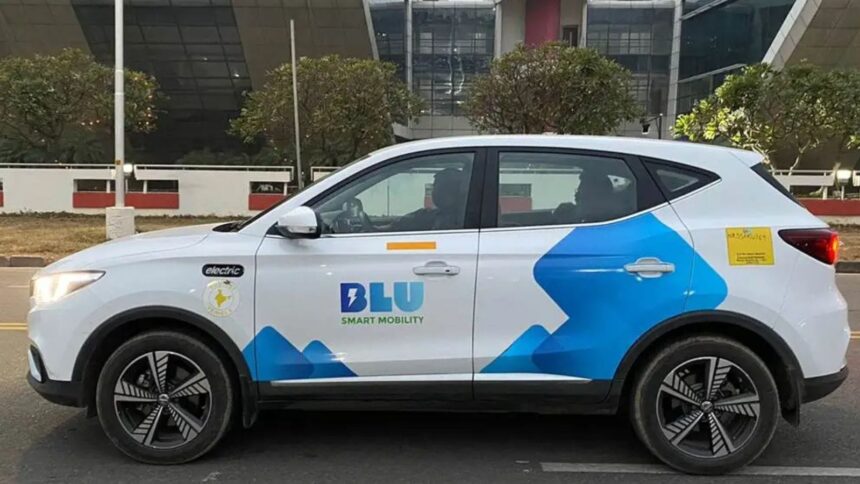India’s $1-billion ride-hailing market is in the thick of disruption—popular electric cab service BluSmart has paused operations, platforms are abandoning commission-based models for subscription fees, and regulators are cracking down on bike taxis.
With BluSmart hitting the brakes on Wednesday, just a day after related-party entity Gensol Engineering Ltd was pulled up by India’s top markets regulator for fund diversion and document falsification, questions are mounting over the future of its 8,000-strong electric vehicle (EV) fleet.
But even as BluSmart’s exit could open up opportunities for rivals in the four-wheeler space, Uber and Ola are facing growing pressure from challengers like Rapido and Namma Yatri, which have scrapped commissions in favour of daily subscription fees for ride partners.
Daily subscription fees—significantly cheaper than per-ride commissions—have proved popular among drivers, helping platforms like Rapido and Namma Yatri onboard more of them. While Uber and Ola continue to charge commissions for cab rides, they’ve been compelled to make the shift to a subscription-based model in the three-wheeler segment.
As platforms adapt their business models, legal uncertainties are compounding the churn. Clarity is still awaited on whether ride aggregators must levy 5 per cent Goods and Services Tax (GST) on passengers for rides booked under the subscription model.
Meanwhile, on April 2, the Karnataka High Court ordered all bike taxi operations in the state to cease by mid-May due to the lack of regulatory guidelines—a precedent that could prompt similar curbs in other states.
What happens to BluSmart now?
After suspending services across -NCR, , and , BluSmart has told customers it may take up to 90 days to refund their in-app wallet balances. Users with sizeable sums parked in their BluSmart wallets have reason to worry—like Gensol, which defaulted on loans meant to procure EVs for leasing to BluSmart, the cab service is also grappling with liquidity issues.
In a March 4 note on Gensol, ratings agency ICRA flagged “delays in debt servicing by more than 15 days to the bondholders of Blusmart in February 2025”. It also noted that BluSmart is a loss-making entity—and with operations now paused, its liquidity concerns could deepen.
BluSmart’s options are narrowing. Gensol—promoted by BluSmart founders Anmol and Puneet Singh Jaggi—is itself in default on loans from the Indian Renewable Energy Development Agency (IREDA) and the Power Finance Corporation (PFC).
The loans, meant for procuring EVs to lease to BluSmart, were secured against hypothecation of the vehicles. This means lenders can now move to recover dues by seizing and monetising a large chunk of its EV fleet.
While BluSmart has also sourced EVs directly from high-net-worth individuals and investors under its “BluSmart Assured” leasing programme, the majority of its fleet is leased from Gensol.
This complicates any possible onboarding of BluSmart’s vehicles onto Uber—as a fleet partner—due to uncertainties over ownership and how Gensol’s defaults may impact the lease agreements.
Gensol had earlier explored selling around 3,000 EVs leased to BluSmart to Bengaluru-based Refex Green Mobility Ltd, but informed investors on March 25 that no deal had been finalised. Now, with the Securities and Exchange Board of India (SEBI) investigating Gensol for financial irregularities, any such transactions are likely to be put on hold.
With BluSmart’s exit, who could benefit?
With BluSmart exiting the cab market, primary competitors Uber and Ola stand to gain market share—but not without resistance.
New entrants like Bengaluru-based Shoffr, which recently launched in Delhi, are already emerging as alternatives. Shoffr, in particular, has gained traction for airport transfers, with social media users praising its reliability and service quality.
Meanwhile, challengers Rapido and Namma Yatri could further limit Uber and Ola’s gains. Their subscription-based pricing model—a flat daily or weekly fee paid by drivers to access the platform—has proven far more popular than the commission-based approach followed by Uber and Ola, which can eat up to 30 per cent of drivers’ earnings.
By moving away from high commissions to lower fees, platforms like Rapido and Namma Yatri are rapidly onboarding more auto and cab drivers. This shift has already pushed Uber and Ola to adopt subscription pricing for their auto partners.
A similar shift to subscriptions for cabs by Uber and Ola cannot be ruled out, though the revenue lost from commissions may be harder to recover through flat fees.
What are the legal hurdles facing the sector?
Under the subscription model, ride fares are often lower as platforms don’t levy the 5 per cent GST on passengers. However, the legality of foregoing tax collection remains unclear.
As earlier reported, Uber switched to a cash-only model for auto rides in February—joining rivals Namma Yatri, Rapido, and Ola—amid conflicting tax rulings on GST applicability for aggregators following the subscription model.
Passengers now pay auto drivers directly—via cash or UPI—while drivers pay aggregators a taxable periodic fee for platform access. No GST is collected from passengers, as the platform only facilitates the ride and doesn’t handle payments.
However, a November 2024 ruling by the Karnataka Authority for Advance Rulings (AAR) held that Uber must continue collecting GST under this model. A contrasting ruling in September 2023 had exempted Namma Yatri on the grounds that it merely connects drivers to passengers and does not provide the transport service itself.
With this ambiguity, the industry has sought clarity from tax authorities on whether the 5 per cent GST applies to ride aggregators operating on subscription models.
Regulatory hurdles have also hit the increasingly popular bike taxi segment.
Following the Karnataka High Court’s order to halt all bike taxi operations by mid-May due to the absence of regulations, around 40 women drivers on April 16 petitioned state Transport Minister Ramalinga Reddy to reconsider the ban.
They’ve sought a clear regulatory framework, temporary permits for compliant operators, and consultations with stakeholders. The court had noted it could not compel the state to frame rules under Section 93 of the Motor Vehicles Act, 1988.
Industry body IAMAI has also urged the government to urgently set up a joint committee to draft bike taxi guidelines.
According to Markets and Data, India’s ride-hailing market could grow from $951 million in 2023-24 to nearly $4 billion by 2031-32, a CAGR of over 18 per cent.








